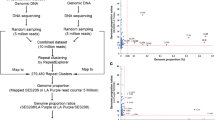Summary
Species-specific highly repeated DNA sequences can be used to screen the progeny of protoplast fusions combining different species. Such probes are easy to clone and can be detected by fast methods, e.g., hybridization to total genomic DNA. Furthermore, due to their high copy number, hybridization signals are strong and represent more than one locus, unlike isozymes or resistance markers. After cloning and screening for species-specific DNA sequences we characterized the highly repeated DNA sequences of the solanaceous species Solanum acaule and Lycopersicon esculentum var. “gilva”. DNA sequencing and hy ridization revealed a prominent, tandemly arranged satellite DNA repeat of 162 bp in Lycopersicon esculentum and a different satellite repeat of 183 bp, also tandemly organized, in Solanum acaule. Each repeat is absent in the respective other species. Therefore, we have used these DNA repeats as markers to distinguish regenerated interspecific somatic hybrids from the respective fusion partners. These hybrids were clearly identified by Southern hybridization and dot-blot assays to the respective 32P-labelled satellite DNA.
Similar content being viewed by others
References
Barnes S, James A, Jamieson G (1985) The organization, nucleotide sequence, and chromosomal distribution of a satellite DNA from Allium cepa. Chromosoma 92:185–192
Bavand M, Gekeler W, Ninnemann H (1985) Laminarströmungsmethoden zum Gießen von Microultradünnschichtgradientengelen und neue Peroxidasefärbung zur Linien-und Artauftrennung von Solanum und Lycopersicon. In: Radola BJ (ed) Proc Elektrophoreseforum. Bode, München, p 284
Bedbrook J, O'Dell M, Flavell RB (1980 a) Amplification of rearranged repeated DNA sequences in cereal plants. Nature 288:133–137
Bedbrook J, Jones J, O'Dell M, Thompson RD, Flavell RB (1980 b) A molecular description of telomeric heterochromatin in Secale species. Cell 19:545–560
Birnboim HC, Doly J (1979) A rapid alkaline extraction procedure for screening recombinant plasmid DNA. Nucleic Acids Res 7:1513–1523
Brunold C, Krüger-Lebus S, Saul MW, Wegmüller S, Potrykus I (1987) Combination of kanamycin resistance and nitrate reductase deficiency as selectable markers in one nuclear genome provides a universal somatic hybridizer in plants. Mol Gen Genet 208:469–473
Dover G (1986) Molecular drive in multigene families: how biological novelties arise, spread and are assimilated. Trends in Genet 2:159–165
Ehlenfeldt MK, Helgeson JP (1987) Fertility of somatic hybrids from protoplast fusions of Solanum brevidens and Solanum tuberosum. Theor Appl Genet 73:395–402
Ganal M, Hemleben V (1986) Different AT-rich satellite DNAs in Cucurbita pepo and Cucurbita maxima. Theor Appl Genet 73:129–135
Ganal M, Riede I, Hemleben V (1986) Organization and sequence analysis of two related satellite DNA in cucumber. J Mol Evol 23:23–60
Grellet F, Delcasso D, Panabieres F, Delseny M (1986) Organization and evolution of higher plant alphoid-like satellite DNA sequence. J Mol Evol 187:495–507
Grunstein M, Hogness D (1975) Colony hybridization: A method for the isolation of cloned DNAs that contain a specific gene. Proc Natl Acad Sci USA 72:3961–3965
Hemleben V, Leweke B, Roth A, Stadler I (1982) Organization of highly repeated satellite DNA of two Cucurbitaceae species. Nucleic Acids Res 10:631–644
Hutchinson J, Abbott A, O'Dell M, Flavell RB (1985) A rapid screening technique for the detection of repeated DNA sequences in plant tissues. Theor Appl Genet 69:329–333
Jones J, Flavell RB (1982 a) The mapping of highly repeated DNA families and their relationship to C-bands in chromosomes of Secale cereale. Chromosoma 86:595–612
Jones J, Flavell RB (1982 b) The structure, amount and chromosomal localization of defined repeated DNA sequences in species of the genus Secale. Chromosoma 86:613–641
Kemble RJ, Barsby TL, Wang RSC, Shepard JF (1986) Mitochondrial DNA rearrangements in somatic hybrids of Solanum tuberosum and Solanum brevidens. Theor Appl Genet 72:787–793
Maniatis T, Fritsch EF, Sambrook J (1982) Molecular cloning: A laboratory manual. Cold Spring Harbor Laboratory
Martinez-Zapater JM, Estelle MA, Somerville CR (1986) A highly repeated DNA sequence in Arabidopsis thaliana. Mol Gen Genet 204:417–423
Melchers G, Labib G (1974) Somatic hybridization of plants by fusion of protoplasts. Mol Gen Genet 135:277–294
Melchers G, Sacristan MD, Holder AA (1978) Somatic hybrid plants of potato and tomato regenerated from fused protoplasts. Carlsberg Res Commun 43:203–218
Messing J, Vieira J (1982) The pUC plasmids and M13 mp7 — derived system for insertion mutagenesis and sequencing with synthetic universal primers. Gene 19:259–268
Murashige T, Skoog F (1962) A revised medium for rapid growth and bioassays with tobacco cultures. Physiol Plant 15:473–497
Ninnemann H, Jüttner F (1981) Volatile substances from tissue cultures of potato, tomato and their somatic fusion products. Comparison of gas chromatography patterns for identification of hybrids. Z Pflanzenphysiol 103:95–107
Ninnemann H, Bavand M, Melchers G (1987) Transfer of cold tolerance from Solanum acaule into Lycopersicon esculentum plants by somatic hybridization (Abstr). 7 wiss Tagung Ges Entwicklungsbiol and deutsche Sekt Int Assoc Plant Tissue Cult 1987, FU Berlin
Pental D, Hamill JD, Pirrie A, Cocking EC (1986) Somatic hybridization of Nicotiana tabacum and Petunia hybrida. Mol Gen Genet 202:342–347
Roddick JG, Melchers G (1985) Steroidal glycoalkaloid content of potato, tomato and their somatic hybrids. Theor Appl Genet 70:655–660
Sanger M, Nicklen S, Coulson AR (1977) DNA sequencing with chain terminating inhibitors. Proc Natl Acad Sci USA 74:5463–5476
Saul M, Potrykus I (1984) Species-specific repetitive DNA used to identify interspecific somatic hybrids. Plant Cell Rep 3:65–67
Yanisch-Perron C, Vieira J, Messing J (1985) Improved M13 phage cloning vectors and host strains: nucleotide sequences of the M13 mp18 and pUC 19 vectors. Gene 33:103–119
Author information
Authors and Affiliations
Additional information
Communicated by G. Wenzel
Rights and permissions
About this article
Cite this article
Schweizer, G., Ganal, M., Ninnemann, H. et al. Species-specific DNA sequences for identification of somatic hybrids between Lycopersicon esculentum and Solanum acaule . Theoret. Appl. Genetics 75, 679–684 (1988). https://doi.org/10.1007/BF00265587
Received:
Accepted:
Issue Date:
DOI: https://doi.org/10.1007/BF00265587




